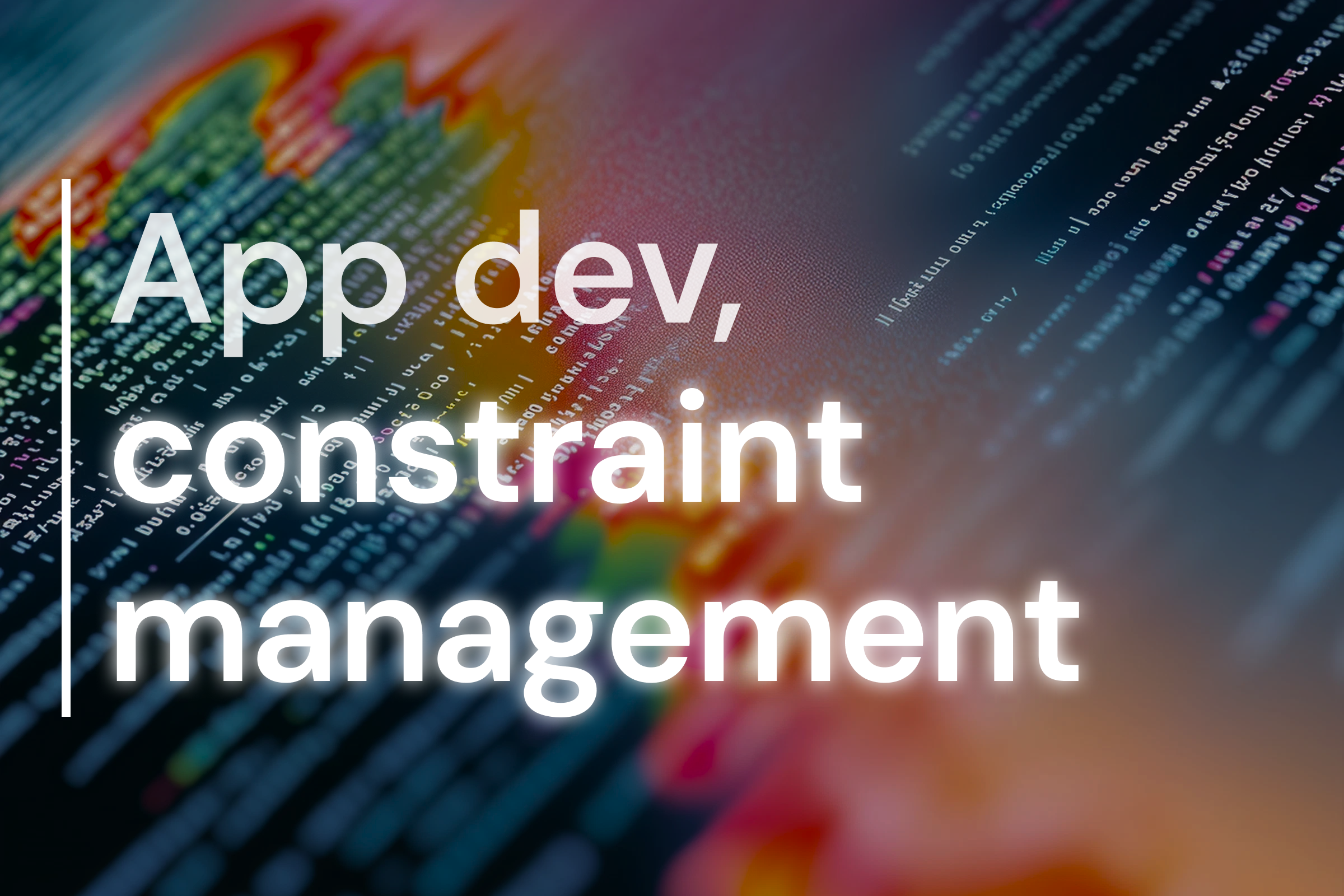Building an app in 2025 is not just about writing code. It is about strategy, market fit, and making smart financial decisions.
If you are here, you are probably asking: "How much will it actually cost?"
The short answer is: "There is no fixed price for app development."
App development is the backbone of digital innovation, powering startups, scale-ups, enterprises, and entrepreneurs with solutions that drive efficiency, engagement, and revenue.
But the true cost depends on multiple factors, including complexity, platform choice, team location, security needs, and long-term maintenance. And let’s be real, hidden costs can sneak up on you if you are not prepared.
In this post, I will explain the triple constraint scope, time, and cost and how each of these factors plays a major role in the cost of building an app. These three pillars directly influence the budget of any app development project.
Reading this, you might want to dig deeper into why app development costs fluctuate in 2025 and how the triple constraint plays a major role.
Let’s break down how these three pillars of pricing, time & scope shape your app budget 👇

The triple constraint of app development
When planning an app development project the concept of the triple constraint scope, time, and cost is crucial.
Whether you are a startup, scale-up, entrepreneur, or large enterprise these three factors determine its success. With these elements from the project management triangle, you have to take into account that when shifting one it inevitably impacts the others.
Mastering this balance of triple constraint in app development is the key to staying on track and within budget.
Scope 🎯
Scope refers to the features, functionality, and complexity of the app. A simple MVP (Minimum Viable Product) will cost significantly less than a feature-rich application with AI or real-time analytics integration. This is to say the broader the scope, the higher the cost.
How does this affect the cost of app development:
1. More features → higher development costs
A simple MVP (Minimum Viable Product) with core features like user login, basic UI, and simple database can be increase cost
A feature-rich app with AI, real-time analytics, or blockchain integration can push costs
Custom-built features (rather than using third-party APIs) further increase development costs due to added engineering time.
2. Increased development time & resources
A broader scope means longer development cycles and larger teams of designers, developers, testers.
More complexity requires advanced technologies, which increase hourly developer rates e.g., AI developers charge more than standard mobile app developers.
How to manage cost when building an app in 2025:
👉 Prioritize only essential features to launch a cost-effective MVP and expand later.
👉 Use third-party services where possible e.g., Firebase for authentication instead of custom-built login.
👉 Adopt Agile development to build in phases rather than committing to everything upfront.
Time ⏳
The development timeline plays a crucial role in determining the overall cost of app development. The faster an app needs to be built, the higher the budget required. Conversely, extending the timeline can help control costs but may delay potential revenue and market entry.
How does this affect the cost of app development:
1. Faster timelines require more resources
- A short timeline demands a larger development team to accelerate work, leading to higher hourly costs.
- Expedited work often means overtime pay, premium rates for developers, and potential quality risks due to rushed execution.
2. Longer timelines spread costs but delay revenue
- A longer timeline allows businesses like scale-ups , startups to manage expenses gradually, reducing the upfront financial burden.
- However, delaying the app’s launch means missing out on early user adoption, feedback, and potential profits.
- Competitors may also enter the market first, making it harder to capture user attention.
How to manage time when building an app in 2025:
1. Set realistic deadlines based on budget & complexity
👉 Avoid unrealistic expectations rushed projects often lead to technical debt, requiring expensive fixes later.
👉 Work with your development team to create a timeline that balances speed, quality, and cost.
2. Consider phased releases to optimize development costs
👉 Launching a Minimum Viable Product (MVP) first allows businesses to test the market while continuing development.
👉 Iterative updates keep costs under control while ensuring the app evolves based on user feedback.
At this Constraint in App Development If speed is a priority, be prepared for higher costs. If budget control is crucial, consider a phased approach to balance expenses while ensuring a high-quality product.
Price 💸
Price is one of the key constraints in the Triple Constraint Model alongside scope and time. It represents the budget limitations that directly influence what can be achieved in an app development project. Since resources are limited, businesses must carefully allocate their budget to ensure a balance between cost, quality, and functionality.
How does this affect the cost of app development:
The total cost of app development includes not just the initial build but also design, testing, and long-term maintenance. Several factors impact overall costs, and managing them wisely ensures a sustainable investment.
1. Developer rates: offshore vs. local teams
- Hiring local developers (e.g., in the U.S., Canada, or Western Europe) can cost $100–$200 per hour.
- Offshore teams in regions like India or Eastern Europe may charge $25–$75 per hour, significantly reducing costs.
- However, offshore development requires strong project management to maintain quality and communication.
2. Technology stack: native vs. cross-platform
- Native apps (iOS & Android separately) offer better performance but require separate development teams, doubling costs.
- Cross-platform solutions (Flutter, React Native) reduce costs by allowing a single codebase for both platforms.
- The choice depends on performance needs and budget constraints.
3. Ongoing costs: maintenance, hosting, and updates
- App maintenance (bug fixes, OS updates, security patches) can cost 15–20% of initial development per year.
- Cloud hosting for backend services (e.g., AWS, Firebase) adds to recurring expenses.
- Marketing, customer support, and future updates are additional costs often overlooked in budgeting.
How to manage cost when building an app in 2025:
Define a clear budget & get multiple quotes
👉 Work with multiple agencies or freelance developers to compare pricing and expertise.
👉 Consider a mix of onshore and offshore resources to optimise quality and costs.
Invest in core features first & scale over time
👉 Start with an MVP (Minimum Viable Product) to test the market before committing to full-scale development.
👉 Use user feedback to determine which features are worth further investment.
Therefore by carefully planning developer selection, technology stack, and long-term costs, start ups , scales-ups etc can build a high-quality app within a realistic budget while keeping future scalability in mind.
How to balance the triple constraint to fit your budget:
Since scope, time, and cost are interconnected, balancing them is essential to ensure your app is developed within budget while maintaining quality.
The key is to prioritise based on business goals, resources, and market needs.
🔹 If you have a limited budget: PRIORITISE SCOPE
✅ Solution: Focus on a Minimum Viable Product (MVP) with only the most essential features.
✅ Trade-off: The app will have fewer features at launch, but you can expand later as revenue grows.
✅ Example: A startup building a fitness app might launch with only basic workout tracking before adding AI coaching later.
🔹 If you need the app fast: PRIORITISE TIME
✅ Solution: Increase the budget to hire more developers or use no-code/low-code platforms for rapid development.
✅ Trade-off: Higher upfront costs but faster market entry, which could lead to earlier user adoption and revenue generation.
✅ Example: A company launching an event app before a major conference may need to pay premium rates to meet the deadline.
🔹 If you want a feature-rich, high-quality app: PRIORITISE COST
✅ Solution: Be prepared for a higher budget and longer timeline to develop an app with custom features and advanced technologies.
✅ Trade-off: The investment is higher, but the app is built for scalability and long-term success.
✅ Example: A fintech app requiring bank-grade security and compliance will need significant investment in development and testing.
At the end of the day, there’s no one-size-fits-all answer to "How much does it cost to build an app?"
it all comes down to balancing scope, time, and cost. The triple constraint defines every project, shaping your budget, development speed, and final product quality.
If keeping costs low is your priority, be ready to limit scope or extend the timeline. Need to launch fast? Expect higher expenses. Want cutting-edge features and top-tier quality? A larger budget and longer dev cycle are part of the deal.
Whether you are a startup, scale-up, or enterprise, making informed decisions now ensures your app is built right, stays on budget, and scales effortlessly in 2025. 🚀
The key to success? Strategic planning. Define your core features, pick the right tech stack, and partner with a team that knows how to build smart.
That’s where nightborn comes in, let's work together to bring your app to life & set you on the path to digital success! 💙



.webp)